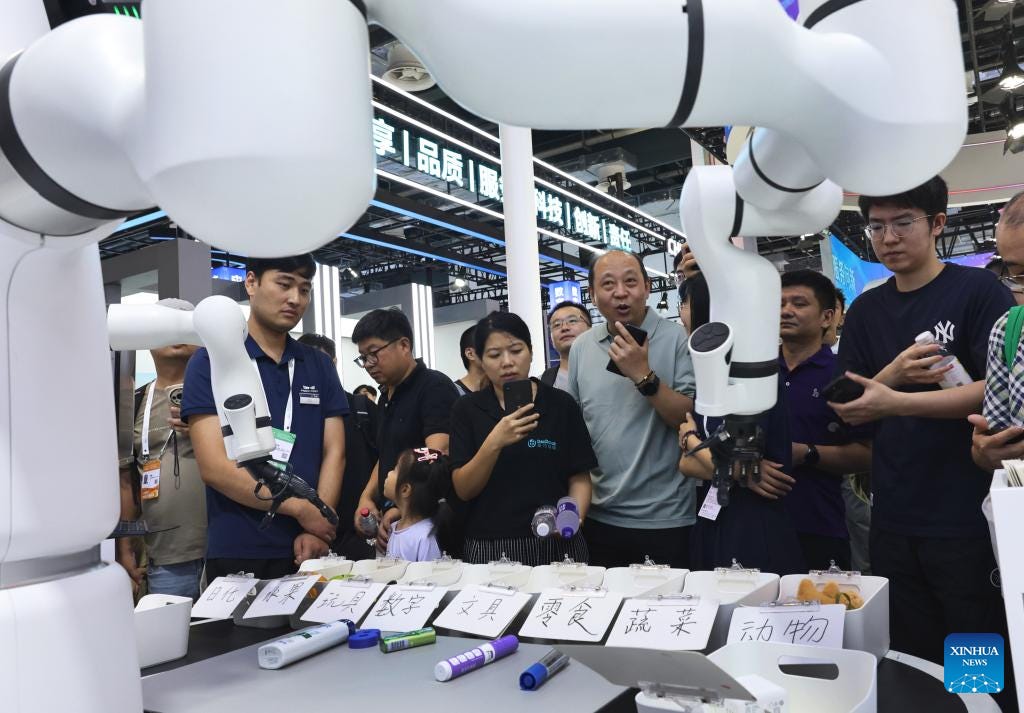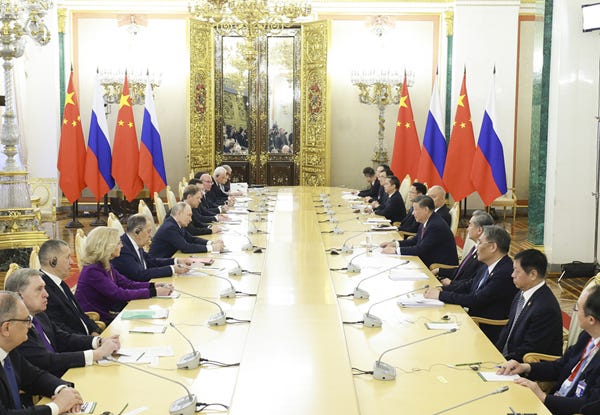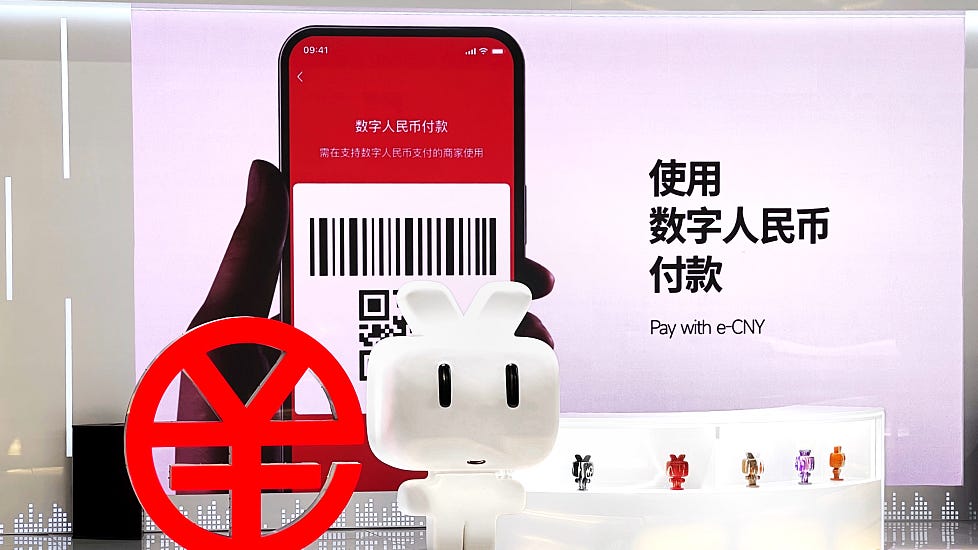Understanding China's Economic Levers of Power: A Conversation with Jim Mullinax on Critical Minerals, Chips, Russia, and the Future of World Order
Jim Mullinax, a Senior Foreign Service Officer with the Department of State, joins OPFOR Journal to discuss strategic competition between the US and China.
Rivalry between the People’s Republic of China (PRC) and the US has intensified in recent months with conflict emerging over key economic issues such as export restrictions on critical minerals and advanced semiconductors, support for Russia’s war in Ukraine, and the future of the international system. This week Jim Mullinax joins OPFOR Journal to discuss these subjects and more in order to provide a sense of the direction that strategic competition is heading between Washington and Beijing.
Jim Mullinax is a Senior Foreign Service Officer with the Department of State. He has served in postings in Asia and Washington DC, including as the U.S. Consul General in Chengdu, China and most recently as Director of the Office of Sanctions Policy and Implementation. He is currently on detail as a Diplomatic Fellow at the Library of Congress, Kluge Center, where he writes and researches on Economic Coercion and Economic Statecraft.
The views expressed below are his own and do not necessarily reflect those of the United States Government or the Department of State.
ON COMPETITION OVER CRITICAL MINERALS:
Dan White:
Hi Jim! Let’s start with critical minerals.
What is the logic behind China’s recent export controls over critical minerals? It seems this may have given the West a needed push to diversify their supplies away from China. Was this a strategic miscalculation on China’s part?
Jim Mullinax:
Thanks Dan, it’s really great to be with you.
You know, for Chinese leaders, the exercise of power in pursuit of national interests is indivisible. There is no carving out of military, diplomatic, political or economic spheres—all the tools are on the table when it comes to advancing Chinese interests. As the PRC economy has grown, leaders have sought to use that economic power to advance its foreign and domestic policy objectives. To their traditional tools of informal or opaque import and export restrictions, consumer boycotts, and regulatory harassment, over the past few years the PRC has added more formal mechanisms like sanctions, export controls, and blocking measures. While these new tools borrow some facets of G7 countries sanctions and export controls, there are important differences, particularly in how the PRC uses them.
The PRC, up to now at least, has used its coercive economic statecraft to retaliate against states or entities that cross key Chinese red-lines like support for Taiwan sovereignty, criticism of Chinese governance, human rights or territorial claims, or actions that threaten Chinese economic development. The recent announcement of export controls on critical minerals should be seen in this light.
Even before President Trump won a second term in office, the PRC was signaling its willingness to retaliate against U.S. measures to ban Chinese drones and, most importantly to the PRC, block Chinese companies from procuring high-end chip manufacturing equipment and chips needed to support Chinese military technology and AI ambitions. China controls a significant percentage of global reserves of certain critical minerals and dominates critical mineral processing. In a global economy that increasingly relies on these critical minerals, export controls restricting access is the PRC’s attempt to retaliate for what it perceives as a threat to its economic development and military technology development ambitions.
Some in the West have been arguing that we need to diversify away from PRC sources for critical supplies ever since the Chinese blocked exports of rare earth metals to Japan following disputes over the Senkaku Islands in 2010. But there is a reason why the PRC dominates critical mineral processing. It’s dirty, it’s not terribly profitable, there are process patents involved, and to process critical minerals at scale takes a degree of practical experience that we no longer have.
A Trump Administration E.O. in March, a Defense Department agreement with MP Materials, and recent reports that the U.S. government would extend price supports to critical minerals miners in the U.S. are overdue steps—although some have expressed concerns about the close relationship between the CEO of MP Materials and Trump’s personal business ventures.
A late start is better than no start, but the fact is that there is no quick fix here. The PRC built their mining and processing industries over 30 or more years. Building mining and processing capabilities in the United States or in allied countries is a project that will take many years—well beyond the current administration—to bear fruit. In the meantime, we’ll need to play a careful game to ensure we continue to have access to critical minerals—mostly from China—while protecting America’s lead in AI and other critical technologies.
ON COMPETITION OVER CHIPS AND AI:
Dan White:
What effect have curbs on advanced semiconductors had on China’s ambition to lead in AI?
Jim Mullinax:
The restrictions on advanced semiconductors to the PRC have certainly changed the way many Chinese companies are approaching AI development. But I don’t see any evidence to suggest that the Chinese authorities or innovators have lowered their ambitions. Uncertain access to the most advanced semiconductors has pushed Chinese innovators to find work-arounds—the most well-known is DeepSeek, but others are also looking for ways to use computing power more efficiently. The need to overcome our restrictions could lead to more Chinese breakthroughs in the future.
The PRC-organized World AI Conference in Shanghai at the end of July illustrated the multi-faceted approach Chinese entrepreneurs and authorities are taking to speed Chinese AI development—pumping resources into practical applications of AI and, importantly, seeking to write the rules of global AI governance. The U.S. currently leads the world in developing AI models and has the best hardware. But AI development and application is still in early stages and first-mover advantages can be leapfrogged. Chinese developers are talented, creative, well-resourced and have government support.

Relying solely on restricting access to technology isn’t likely to be a long-term winning strategy. The Trump Administration has encouraged investments in AI infrastructure, adopting AI tools in the workplace and exporting U.S. AI solutions to partners. We need to move forward on all fronts to ensure we’re in a position to set the rules in this competition.
ON CHINA’S SUPPORT FOR RUSSIA:
Dan White:
A recent report by German military intelligence alleges that China is responsible for 80% of all sanctions evading trade with Russia. How does this trade work? What are the opportunities to disrupt it that haven’t yet been used?
Jim Mullinax:
I’m not familiar with that report, but there is no doubt that trade with China is incredibly important for Russia and a significant proportion of trade in controlled items or with sanctioned entities has a Chinese touchpoint. In some cases, Chinese companies may be selling directly to sanctioned Russian buyers. But more often we see increasingly complicated chains of transactions transferring controlled technology through numerous companies and multiple countries in an attempt to obscure both the origins and the destinations for the goods.
As an example, a shell company in Hong Kong set up by a Russian citizen might contract with a manufacturer in the PRC to provide a restricted good to be delivered to a buyer in the UAE who mislabels it and ships the item to Kazakhstan, where it is sold on to a Russian buyer who receives the item and passes it to a sanctioned Russian company. The transaction may be financed at the direction of a Russian shell company in Turkiye by a payment from a UAE bank to a municipal level Chinese bank. Many hands, misleading or altered paperwork, and transit through jurisdictions that may have less capability or willingness to enforce export controls all can play a role in evading these restrictions.
As much as we’d like to, we can’t stop all evasion. But these complex transactions undertaken to evade sanctions are more difficult, more time consuming and far more costly than procurements prior to the war. If we can’t fully stop them, at least we can slow them down and make them bleed resources. It’s important that we continue our efforts to identify and sanction new touchpoints in evasion networks. Sanctioning these pop-up companies is like playing whack-a-mole. As soon as you hit one, another raises its head. Without constant maintenance our sanctions will lose their effectiveness.
We’ve also had some real success working with countries to stop transshipment; that also needs to continue. The Trump Administration has proposed some creative new ways to exert pressure on countries that are continuing to support trade with Russia—punitive tariffs could be part of an effective strategy. President Trump could also use existing authorities to impose sanctions on more foreign financial institutions involved in Russia trade, including in China and India. There is more we can do with transshipment countries—including the PRC—to address our concerns before imposing sanctions. Threats from President Trump are uniquely credible—that’s a tool we can use to tighten the noose on Russia’s illicit trade.
Dan White:
What measures would the West need to take to deter China from supporting Russia economically, or is the relationship between the two countries truly “no limits?”

Jim Mullinax:
The “no limits” partnership between Russia and China clearly has limits. These are not allies—they are countries that share common antipathy to the Western-led global order. Their partnership is a function of their self-interest. The PRC has declined to send munitions to Russia—though it has sent crucial dual use technology—showing the partnership does have some limits. However, we should take PRC Foreign Minister Wang Yi seriously when he says the PRC would not like to see Russia lose the war.
China has taken the opportunity of the West’s divestment from Russia to step in to provide goods Russian consumers want, from cars to mobile phones. It’s unlikely that anything the U.S. or G7 partner countries could do would stop that trade. What we can and should do is focus on disrupting the supply of dual use items that are fueling the Russian war machine. That could mean sanctioning significant Chinese banks involved in evasion, enforcing our export controls, and introducing targeted trade measures, all supported by a concerted diplomatic campaign designed to spell out the benefits of compliance.
Increasing costs, timelines, and uncertainty for Russian military suppliers, while visibly supporting Ukraine’s defense, offers the best chance to bring Russia to the negotiating table with a constructive attitude.
ON CHINA’S ATTEMPT TO RIVAL THE DOLLAR:
Dan White:
China has advertised its digital yuan as an alternative to the US dollar. The centralized nature of the digital currency combined with China’s own temperamental attitude toward trade would seem to make this a risky investment. Why would a country want to use the digital yuan or not? Where is China hoping to see the digital yuan adopted?

Jim Mullinax:
China’s digital currency—the e-RMB—is an extension of Chinese ambition to both insulate itself from reliance on the dollar as a medium of international exchange and also a tool to manage the domestic economy. Domestically, China is the global leader in adoption of virtual payments—just try living in China without WeChat or AliPay—it’s virtually impossible! Chinese consumers are already accustomed to digital payment systems. A government-sponsored digital currency can be a useful domestic monetary policy tool—helping policymakers see quickly and respond to price and stability fluctuations. Not coincidentally, it also gives policymakers a clear view of how money is being spent, where and by whom. This can be a useful tool in combating fraud and illicit transactions—but it can also be used to monitor and disrupt individual financial activities the government doesn’t support, needless to say, a real concern in an authoritarian country like the PRC.
On the international side, the PRC undoubtedly sees the global dominance of the USD in trade and international finance as a risk to their freedom of action and has sought to internationalize the RMB in part to lessen its dependence on the dollar. A government backed digital currency could facilitate cross-border payments in RMB, making them quicker and easier, as well as making it easier to avoid the sanctions risks that might accompany dollar exposure. As the world’s largest trading nation, making it easier, cheaper and quicker to make international payments is good for China and for its trading partners—especially those economies in the Global South that may not have robust correspondent banking relationships with international financial institutions.
The PRC has been piloting central bank digital currency projects since 2014, including in cooperation with other nations and international financial institutions. For example, Project mBridge, led by the Bank for International Settlements, included participation from Thailand, the UAE, Saudi Arabia, as well as the PRC and Hong Kong and was designed to use digital currencies to facilitate the flow of cross-border payments. As other countries consider establishing their own digital currencies, China’s experience and technology platforms could be attractive models, potentially giving the PRC a greater leadership role in global digital currency ecosystem. Again, the ease of use for trading partners needs to be balanced against the possibility of increased PRC surveillance.
ON CHINA’S CONCEPT OF WORLD ORDER:
Dan White:
China champions “multipolarity” through BRICS+ and the Shanghai Cooperation Organization, but when you look closely at China’s actual behavior—its Belt and Road lending practices, its approach to the South China Sea, its treatment of smaller neighbors—it often looks more like Beijing seeking to be the dominant pole with others orbiting around it. Is China’s vision of multipolarity actually just a more palatable way of describing Chinese hegemony? And if so, how long before partners like India and Russia recognize this contradiction?
Jim Mullinax:
You’ve hit on one of the key contradictions in Chinese foreign policy—PRC multilateralism often tends to look like a form of center/periphery economic imperialism. The PRC is fond of large international gatherings—with African countries (FOCAC), with the Caribbean (CELAC), Arab states and others. But what these all have in common is that the PRC sets the agenda and the partner states show up seeking benefits. Former FM Yang Jiechi’s comment at the ASEAN Regional Forum in 2010 that “China is a big country and other countries are small countries” is still reflected in the patterns of PRC regional engagement.
Many countries have already realized that relationships with the PRC can be complicated and have begun re-thinking how they engage with Chinese partners. You can see this most clearly in Eastern Europe’s relationship with the PRC. From a China+17 forum, the number of Eastern European states willing to engage in that format with the PRC dropped to zero in the face of pressure to conform to Chinese policy preferences on relations with Taiwan, human rights, concerns, and most recently, the PRC’s support for Russia’s war in Ukraine.
Chinese efforts to exert influence through the BRICS grouping have also been undermined by the expansion of the group to include new members that have diverse policy preferences, diluting China’s ability to set the agenda. Even China’s “no limits” partner, Russia, reportedly tasked its intelligence agencies to increase their collection on the PRC.
However, Yang isn’t wrong—China is a big country—and others, whether India, Russia, Europe, or the United States, have to find ways to engage with China that advance their policy interests. Those who can hedge, will.
Dan White:
Xi Jinping missed the BRICS+ Summit in Rio de Janeiro in July. It was the first time he has missed the summit as leader. It would seem to have been a major missed opportunity to challenge US global leadership in America’s backyard. Why do you think he skipped out on it? Was his absence motivated by solidarity with Putin who also didn’t attend due to an outstanding global arrest warrant? Due to not wanting to be upstaged by Narendra Modi who was given a state dinner by Brazil? China losing interest in BRICS? Something else?
Jim Mullinax:
Xi’s absence from the BRICS meeting in Brazil sparked a flurry of online speculation. Was he ill? Is he under some kind of domestic pressure? Was he snubbing Brazilian President Lula or worried about being upstaged by the Modi dinner? I don’t know the answer, but my guess is that Xi didn’t see a lot of value in traveling to Brazil for the event, given he had just met with Lula in Beijing. The BRICS expansion also makes it a very different organization from what it was at its origin. The outcomes of the BRICS Summit were not particularly high profile, making it less important for Xi to attend. While it’s too early to say that the PRC has lost interest in BRICS, changing international dynamics and the evolution of the organization may make it less important to the PRC in the future. Next year’s Summit in India may tell us more.
Dan White:
That is all the questions I have. Thank you for shedding light on these important issues Jim!
To read more from Jim on economic statecraft and Chinese economic coercion, check out some of his most recent articles below.
“China's New Economic Coercion Toolkit”, The Diplomat, March 22, 2025
“Seizing Russian Assets Won't Undermine the Euro”, The National Interest, March 2, 2025





This was fantastic. More interviews please.